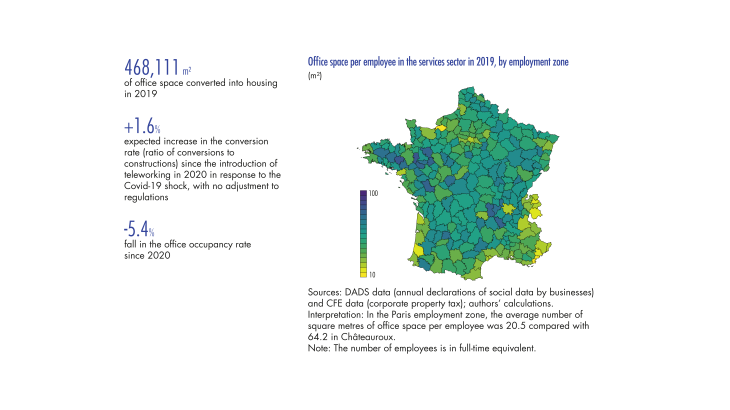1 The surge in teleworking since the Covid 19 shock is driving down demand for offices
The introduction of social distancing measures in 2020 accelerated the spread of teleworking, and in just a few months it became standard practice for those able to do at least part of their jobs outside the workplace. In France, as in other European countries, the number of people working from home one or two days a week has increased sharply (from 3% of employees in 2019 to over 15% at the start of 2022 in France according to the Acemo Covid survey conducted by the government labour statistics office, DARES). This structural change could lead to major shifts, especially in urban geography. For example, workers who split their time between home and the office can move further away from urban centres, thereby reducing the income share they spend on housing. Businesses can also benefit significantly by reducing the volume of real estate they occupy, as it is becoming increasingly expensive and limits their flexibility due to standard real estate market frictions – for example the length of leases (Bergeaud and Ray, 2020)
In a recent article, Bergeaud, Garcia and Henricot (2023) identify the existence of a negative demand shock in commercial real estate linked to the introduction of teleworking. Moreover, observed changes in prices and vacancy rates suggest that investors and other real estate professionals expect this shock to become permanent. This fall in demand should contribute to a moderation of commercial real estate prices, at least in those areas where the market is tightest (see, for example, Gupta, Mittal and Van Nieuwerburgh, 2022 for a study of New York).
To what extent could this trend affect residential real estate, i.e. real estate owned by households and used for housing? To attempt to answer this question, we need to examine the links between commercial and residential real estate. The two markets have several common determinants: both are boosted by the cultural or natural environment (e.g. presence of a river), and both benefit from positive externalities linked to agglomeration mechanisms (Duranton and Puga, 2004).
To illustrate the strong link between the two segments, we estimate the correlation between the price of a standard dwelling and the price of a standard office in each employment zone, using government data on real estate transactions (DV3F database).
[to read more, please download the article]
